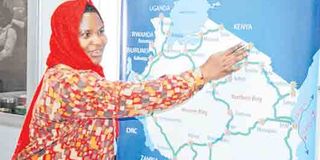Use of ICT broadband backbone low despite huge spending: experts

What you need to know:
According to a report by the Ministry of Works, Communications and Transport, in 2016 alone $189 million was set aside for the project.
Dar es Salaam. The National ICT Broadband Backbone (NICTBB) is underutilised despite heavy spending in undertaking it.
According to a report by the Ministry of Works, Communications and Transport, in 2016 alone $189 million was set aside for the project.
With optic fibre network covering over 7,000km of the country, for rolling out ICT infrastructure investment projects, it is estimated that over 70 per cent of the backbone is not used in many districts.
The situation raises queries over public awareness, spread of technology, affordability and other factors which may be the reasons for its low utilization.
The dean of the School of Informatics at the University of Dodoma, Prof Justinian Anatory, told BusinessWeek that Tanzania was lagging behind three East African countries in the use of National ICT Optic Fibre Network, the NICTBB.
“2016 studies by the World Economic Forum and the World Bank showed that in terms of government and institutional uses of optic fibre networks Rwanda is leading, followed by Kenya, while Uganda is in the third followed by Tanzania at the bottom,” said Prof Anatory who also said in ICT business performance and enterprise connectivity, Kenya was leading, while Rwanda was the second followed by Uganda which was close to Tanzania.
In terms of individual performance and usage Tanzania was also at the bottom while the three East African nations outmatched it in the same index.
According to him, the NICTBB is still a white elephant due to a number of factors, including among others affordability, spread of technology and low level of ICT skills development.
Other factors, according to him, are backward national policy and low level of public awareness.
“The national ICT policy and corresponding regulations are acting as a fetter to the development ICT businesses in the country. The case in point is the fact that in Rwanda’s ICT policy there is a regulation binding business entities and government institutions to communicate electronically, but there is no such regulation in Tanzania,” he says.
According to him, although there is a programme of e-government in Tanzania, it is little used.
An ICT analysis shows that even the growing criminal activities like upsurge of Rufiji killings could be easily combated by ICT devices coupled with collaboration between police and civilians.
“In terms of ICT affordability, ICT products in the country are more expensive than in Kenya and Rwanda,” says Prof Anatory.
Even the Tanzania Telecommunications Company (TTCL), which supervises the NICBB is not innovative enough to design and market more ICT products for dynamic conduct of ICT businesses in the country,” he says.
The same issue was raised by the chief executive officer of Dar Telecommunications Business Incubator Project, Mr George Mulamula, at a budget forum organised by Deloitte recently, who said the ICT backbone in the country was underutilised, indicating less value for money in terms of its usage.
Over 70 per cent of its huge business potential is not in use putting the country, says Mr Mulamula whose project is under the Commission for Science and Technology.
He likened optic fibre networks in Tanzania to well-built tarmac roads, where few vehicles pass on them.
“The 2017/18 budget has not addressed the need to spur investments in ICT business so that the country is able to put in place strong tax base for further economic growth.” With 7,400km of optic fibre cable already constructed, the backbone has been extended to eight border points of Sirari, Namanga and Horohoro (Kenya); Mtukula (Uganda), Rusumo (Rwanda), Kabanga and Manyovu (Burundi), Kasumulo (Malawi) and Tunduma (Zambia), according to 2016 report of the ministry responsible for communications. The same report says that with a view to fulfill the government’s commitment to connect the landlocked countries to the international submarine cables landing in Dar es Salaam (currently Seacom and Eassy) and thereby making Tanzania a hub of ICT infrastructure and ICT solutions within the region, service providers in Rwanda, Burundi, Malawi and Zambia have already connected to NICTBB, while operators in Kenya and Uganda will soon connect to the backbone.
The new development also makes Tanzania more capable of ‘exporting’ the cable’s capabilities to neighbouring countries like Rwanda, Burundi, Uganda, Malawi, Zambia and Mozambique.
Supervised by TTCL, the NICTBB is operated as a wholesale business that is engaged in lease of capacity to Tanzania’s licensed operators, notably mobile network operators, internet service providers, local television and radio stations, fixed network, fixed wireless voice and data service providers, according to the same report.
TTCL completed the project of constructing main routes of NICTBB in July 2015.
, while is supervising the process of mobilising IT businesses and marketing it to users throughout the country, according to TTCL report of 2015.




